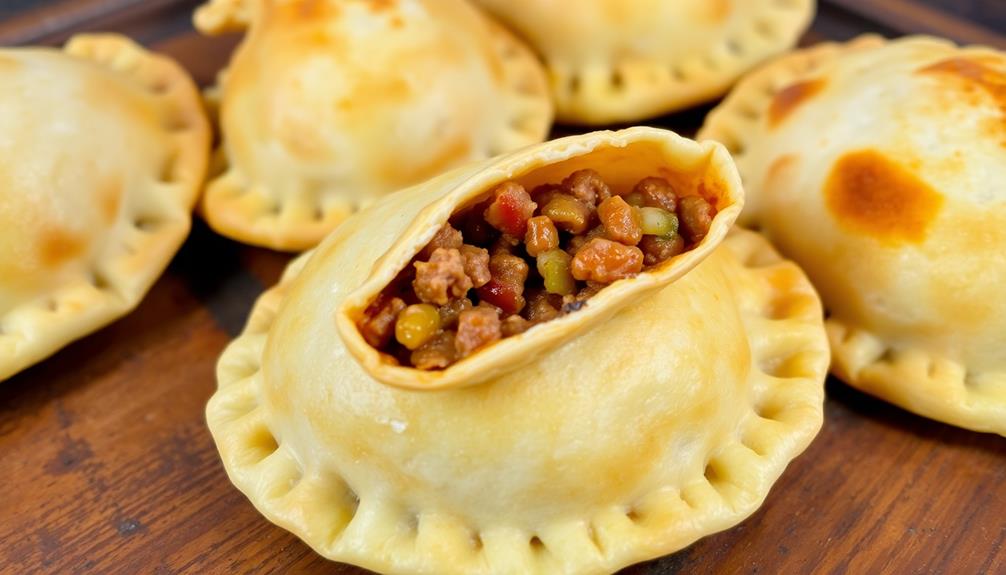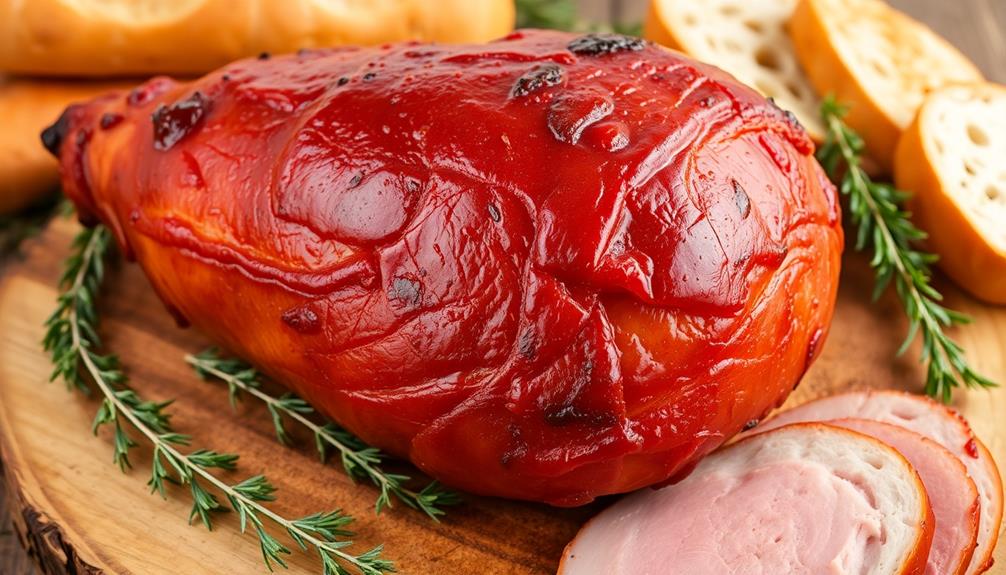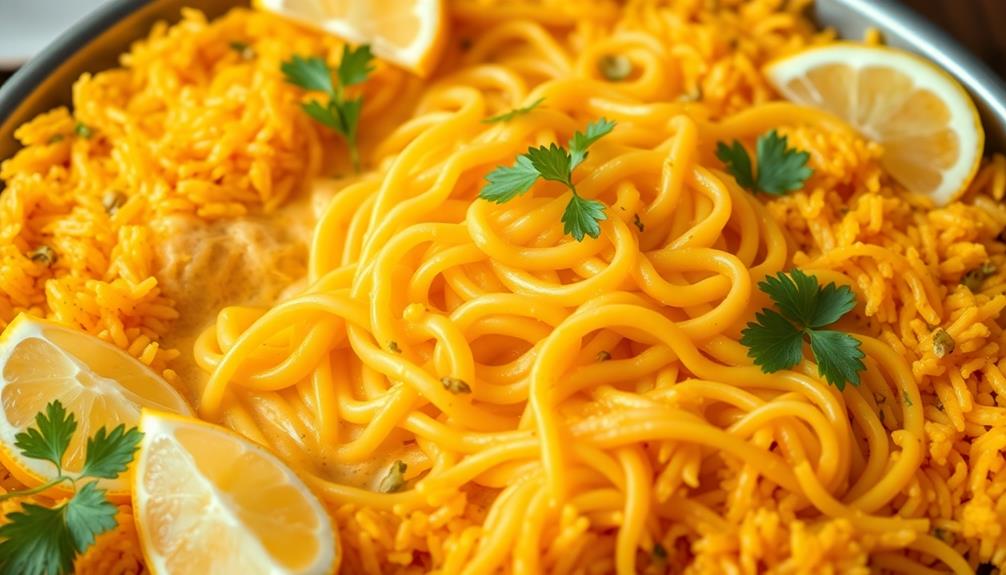Empanadas are savory pastries that originated in the Iberian Peninsula and evolved across Latin America. They're often filled with meat, seafood, or veggies, though the fillings can get quite creative. To make them, you'll mix up a simple dough, stuff it with your choice of goodies, then bake until golden brown. Empanadas are cherished in many cultures, making them perfect for celebrations or just a tasty snack. Serve them warm with dipping sauces like salsa or chimichurri for an authentic experience. There's so much more you can discover about these incredible handheld pastries!
Key Takeaways
- Empanadas are traditional pastries that originated in the Iberian Peninsula and have evolved across Latin America, reflecting local ingredients and culinary traditions.
- The dough for empanadas is made from a simple mixture of flour, butter, and water, while the fillings can vary from savory meats to sweet fruits.
- Empanadas are typically baked at high temperatures to achieve a flaky crust and can be served as appetizers, main courses, or desserts.
- Empanadas are versatile and adaptable, making them suitable for various dietary preferences and occasions, from casual gatherings to formal events.
- Serving empanadas with dipping sauces like salsa, chimichurri, or garlic aioli can enhance the overall dining experience and showcase the flavors of the dish.
History
Empanadas have a rich and diverse history, dating back centuries to the Iberian Peninsula. These savory pastries originated in Spain and Portugal, where they were initially filled with meat, seafood, or vegetables.
As empanadas spread throughout Latin America, the fillings evolved to reflect local ingredients and culinary traditions. In Argentina, for instance, you'll find empanadas stuffed with beef, onions, and spices, while in Chile, they're often filled with seafood like tuna or shrimp.
The crimped, half-moon shape of the empanada is a hallmark of the dish, created by carefully folding and sealing the dough around the filling.
Empanadas have become a beloved part of celebrations and gatherings across the Hispanic world. Whether baked or fried, these portable pockets of flavor have captured the hearts and stomachs of people everywhere.
From family gatherings to festive events, empanadas continue to be a cherished culinary tradition, connecting cultures and creating delicious memories.
Recipe
Empanadas are a beloved savory pastry that originated in Spain and Portugal, but have since become a staple in Latin American cuisines. These delectable hand-held pies can be filled with a variety of ingredients, making them a versatile and delicious option for any occasion.
The dough for empanadas is typically made with a combination of flour, butter or lard, and water, creating a flaky and buttery crust that perfectly complements the fillings. The fillings, on the other hand, can range from seasoned ground meat to sautéed vegetables, cheese, or even sweet options like fruit.
Ingredients:
- 2 cups all-purpose flour
- 1/2 teaspoon salt
- 1/2 cup cold unsalted butter, cut into cubes
- 1/4 cup cold water
- 1 pound ground beef
- 1 onion, finely chopped
- 2 cloves garlic, minced
- 1 teaspoon paprika
- 1 teaspoon cumin
- 1/2 teaspoon oregano
- Salt and pepper to taste
- 1 egg, beaten with 1 tablespoon water for egg wash
Instructions:
In a large bowl, combine the flour and salt. Cut in the cold butter until the mixture resembles coarse crumbs. Gradually add the cold water, mixing until the dough just begins to come together. Shape the dough into a disc, wrap in plastic, and chill for at least 30 minutes.
In a skillet over medium heat, cook the ground beef, onion, and garlic until the beef is browned and the onion is soft. Drain any excess fat, then stir in the paprika, cumin, oregano, salt, and pepper. Allow the filling to cool slightly.
Preheat your oven to 375°F (190°C). On a lightly floured surface, roll out the chilled dough to about 1/8-inch thickness. Cut out circles using a 5-inch round cookie cutter or biscuit cutter. Place a heaping tablespoon of the filling in the center of each circle, then fold the dough over to create a half-moon shape. Crimp the edges with a fork to seal.
Place the empanadas on a baking sheet lined with parchment paper. Brush the tops with the egg wash. Bake for 20-25 minutes, or until the crust is golden brown. Serve hot and enjoy!
Tips:
For a crispy crust, be sure to chill the dough well before rolling and assembling the empanadas. You can also try using a combination of all-purpose and whole wheat flour for a heartier texture. Additionally, feel free to experiment with different fillings, such as chicken, cheese, or roasted vegetables, to find your perfect flavor combination.
Cooking Steps
Prepare the dough by mixing the ingredients until a smooth ball forms.
Stuff the empanada dough with your desired filling, then crimp the edges to seal them tightly.
Step 1. Prepare the Dough

To begin, gather the necessary ingredients for the dough: all-purpose flour, salt, cold butter, and ice water.
In a large bowl, combine the flour and salt. Cut the cold butter into small pieces and add it to the flour mixture. Using your fingertips, gently rub the butter into the flour until it resembles coarse crumbs.
Next, add the ice water, a tablespoon at a time, mixing gently with a fork until the dough just begins to come together. Be careful not to overmix. Shape the dough into a disc, wrap it in plastic, and refrigerate for at least 30 minutes. This resting period allows the gluten to relax, making the dough easier to roll out.
Once chilled, lightly flour a clean surface and roll out the dough to your desired thickness. Cut the dough into circles or your preferred shape, ready to be filled and sealed for baking.
Step 2. Stuff the Empanada Dough
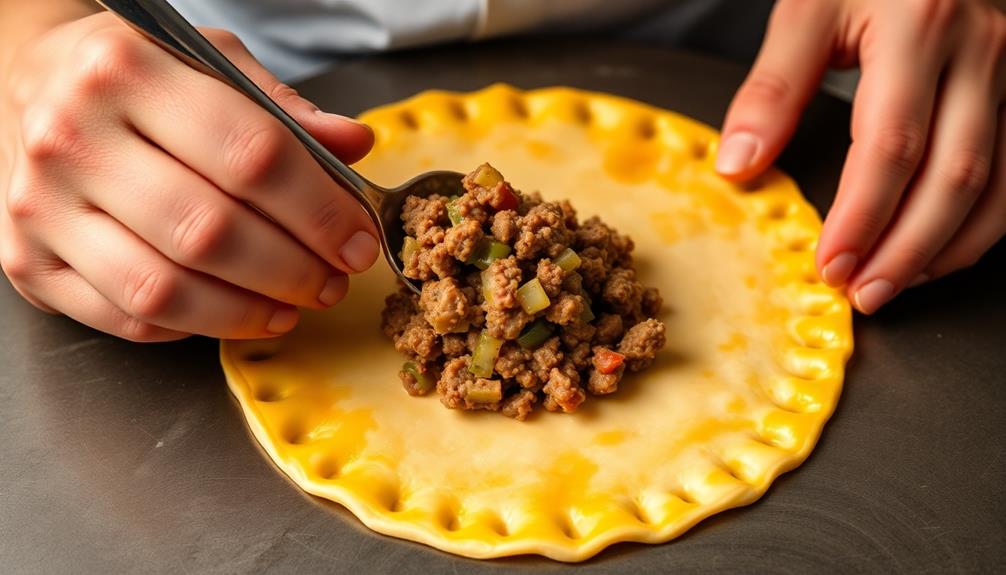
With the dough ready, the stage is set to bring your empanada vision to life.
First, prepare your fillings. Sauté onions, garlic, and any other desired vegetables until soft. Add seasoned ground meat, chicken, or vegetables, cooking thoroughly. Allow the filling to cool slightly.
Next, take a portion of the dough and roll it into a circle about 1/8 inch thick. Scoop a heaping tablespoon of the filling into the center. Fold the dough over, creating a half-moon shape, and crimp the edges with a fork to seal.
Repeat with the remaining dough and filling.
Carefully transfer the stuffed empanadas to a baking sheet. Brush the tops with an egg wash for a golden sheen. Bake at 400°F until the dough is flaky and the filling is hot, about 20-25 minutes. Serve warm and enjoy your homemade empanadas!
Step 3. Crimp the Empanada Edges
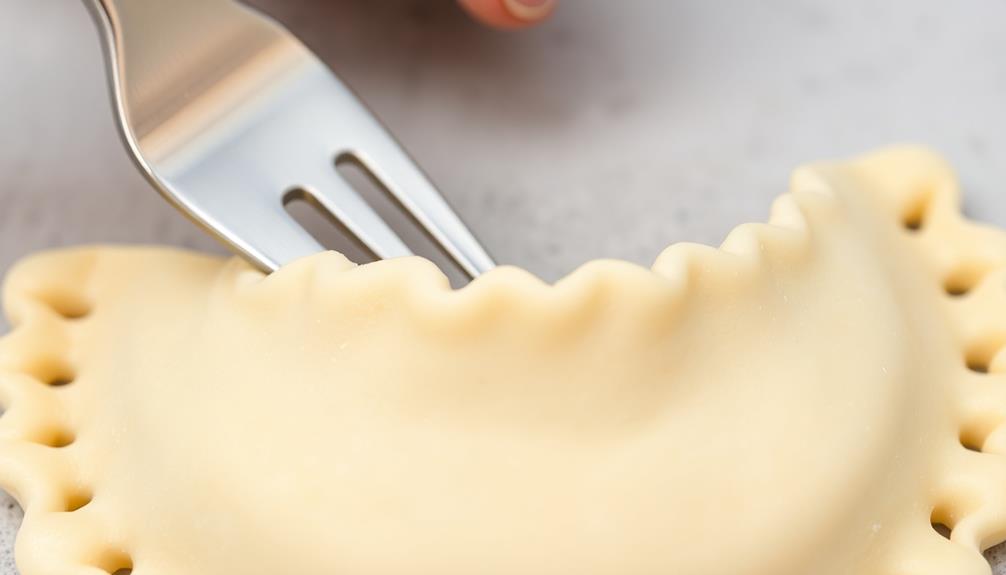
Once you've placed the filling in the center of the dough circle, it's time to crimp the edges. Take the dough and fold it in half, creating a half-moon shape. Starting at one end, use your fingers to press and seal the dough, creating a tight, crimped edge.
Work your way around the entire half-moon, sealing the dough to keep the filling tucked inside. For a decorative touch, you can use the tines of a fork to crimp the edges, gently pressing down and creating a beautiful pattern. This not only seals the empanada but also adds a visually appealing look.
Be careful not to press too hard, as you don't want to pierce the dough. Once the edges are crimped, your empanada is ready for baking or frying. The crimped edges will help the filling stay put and create a delicious, flaky crust around your delightful treat.
Step 4. Bake Empanadas in Oven
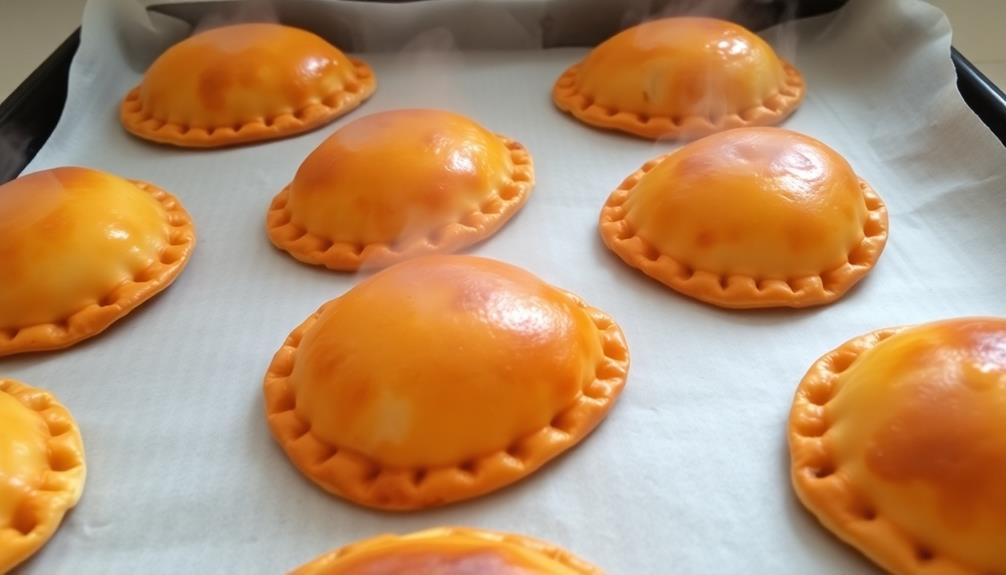
After sealing the crimped edges, your empanadas are ready for baking. Preheat your oven to 400°F (200°C). Line a baking sheet with parchment paper or a silicone baking mat.
Arrange the sealed empanadas on the prepared baking sheet, making sure they're not touching each other. This will allow for even baking and prevent the empanadas from sticking together.
Brush the tops of the empanadas lightly with an egg wash or milk. This will give them a nice, golden-brown color when baked.
Place the baking sheet in the preheated oven and bake for 20-25 minutes, or until the empanadas are golden brown and flaky. Keep an eye on them, as oven temperatures can vary.
Once baked, remove the empanadas from the oven and let them cool for a few minutes before serving. Serve hot, with your favorite dipping sauces or toppings, and enjoy your homemade empanadas!
Step 5. Serve Empanadas Warm

Serving your freshly baked empanadas warm is key to enjoying their delightful flavors and textures. As soon as you remove the empanadas from the oven, let them cool for a minute or two. This allows the filling to set, preventing any spills or leaks when you take your first bite.
When ready to serve, place the warm empanadas on a serving platter. You can leave them whole, or if desired, slice each one in half diagonally. This makes them easier to handle and share.
For a special touch, you can garnish the platter with a sprinkle of chopped cilantro or parsley.
Encourage your guests to enjoy the empanadas right away, while they're still piping hot. The flaky crust and savory filling are at their best when freshly baked.
Serve the empanadas with your choice of dipping sauces, such as salsa, chimichurri, or garlic aioli, to enhance the flavors even further. If you’re looking to pair the empanadas with additional Spanish-inspired dishes, consider serving with an authentic Spanish gambas al ajillo recipe. This classic dish features succulent shrimp, sizzled to perfection in a garlic-infused olive oil. The combination of flavors from the empanadas and gambas al ajillo will transport you and your guests to the bustling streets of Spain.
Final Thoughts
Undoubtedly, empanadas have become a beloved staple in kitchens worldwide. These versatile pastries aren't just a delicious meal – they're a cultural treasure that brings people together.
Whether you're hosting a lively fiesta or enjoying a quiet family dinner, empanadas are the perfect addition to any occasion.
As you've explored the art of making these flavorful pockets, remember that the joy of empanadas lies in their simplicity and adaptability.
Don't be afraid to experiment with different fillings, from savory meats to sweet fruits. The beauty of empanadas is that they can be tailored to suit every palate.
As you continue your empanada journey, remember to savor the process and the final product.
These bites of goodness aren't just nourishment for the body, but also for the soul.
Frequently Asked Questions
What Is the Difference Between an Empanada and a Calzone?
You might be wondering about the difference between an empanada and a calzone. While they're both savory pastries, an empanada is typically baked or fried, while a calzone is usually baked and has a distinctive half-moon shape.
Can Empanadas Be Frozen and Reheated Later?
Yes, you can absolutely freeze and reheat empanadas later. They'll retain their flavor and texture well, making them a convenient make-ahead option. Just be sure to wrap them tightly before freezing to prevent freezer burn.
What Are Some Common Fillings for Vegetarian Empanadas?
Vegetarian empanadas can be filled with a variety of tasty ingredients. Some common fillings include roasted vegetables, black beans, cheese, and spices. You can get creative and use whatever vegetables or legumes you enjoy.
How Do I Prevent the Empanada Dough From Becoming Too Dry?
To prevent the dough from becoming too dry, you should incorporate a little extra liquid, such as water or milk, into the mixture. This will help keep the dough pliable and prevent it from becoming crumbly.
Can I Use Store-Bought Dough Instead of Making It From Scratch?
You can certainly use store-bought dough instead of making it from scratch. This can be a convenient option, allowing you to focus on the filling and assembly of your dish without the added effort of dough preparation.
